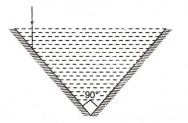CBSE Multiple Choice Questions
Multiple Choice QuestionsA vessel consists of two plane mirrors at right angles (as shown in the figure). The vessel is filled with water. The total deviation in incident ray is

0°
90°
180°
none of these
Golden view of sea shell is due to
diffraction
polarisation
dispersion
reflection
The working of which of the following is similar to that of a slide projector?
Electron microscope
Scanning electron microscope
Transmission electron microscope
Atomic force microscope
A ray of light is traveling from glass to air, (refractive index of glass= 1.5). The angle of incidence is 50°. The deviation of the ray is
0°
80°
A person standing in front of a mirror finds his image larger than himself. This implies that the mirror is :
convex
parabolic
plane
concave
A flat mirror revolves at a constant angular velocity making 2 revolutions/s. With what velocity will a light spot move along a spherical screen with a radius of 10 m if the mirror is at a centre of curvature of the screen?
251.2 m/s
261.2 m/s
271.2 m/s
241.2 m/s
A ray falls on a prism ABC (AB = BC) and travels as shown in the figure. The least value of the refractive index of the material of the prism should be;

1.5
1.33
Magnification of a compound microscope is 30. The focal length of eye-piece is 5 cm and the image is formed at a distance of distinct vision of 25 cm. The magnification of the objective lens is:
6
5
7.5
10
The Cauchy's dispersion formula is
n = A + Bλ-2 + Cλ-4
n = A + Bλ-2 + Cλ4
n = A + Bλ2 + Cλ-4
n = A + Bλ2 + Cλ4
An object is placed at a distance equal to the focal length of a convex mirror. If the focal length of the mirror is f, then the distance of the image from the pole of the mirror is :
less than f
equal to f
more than f
infinity

